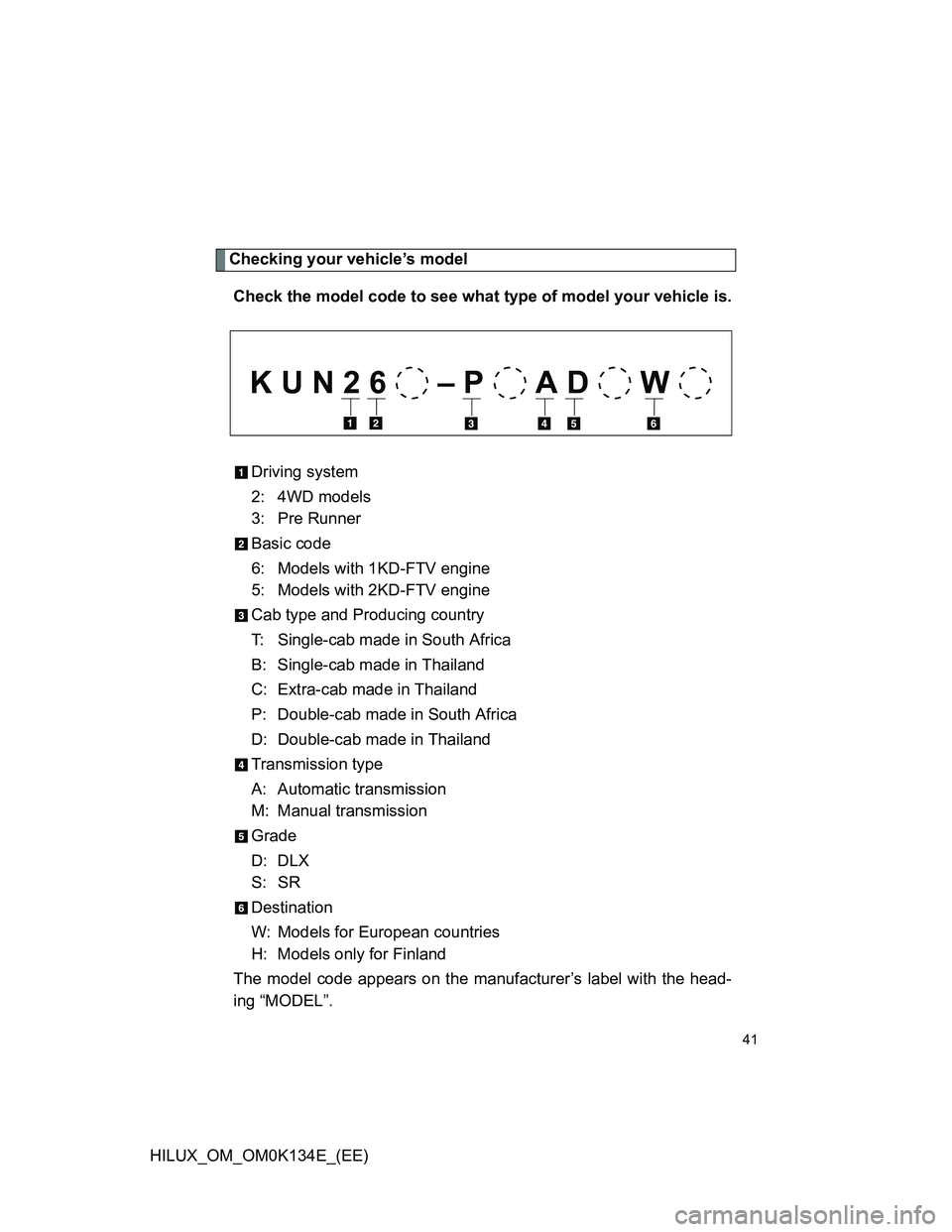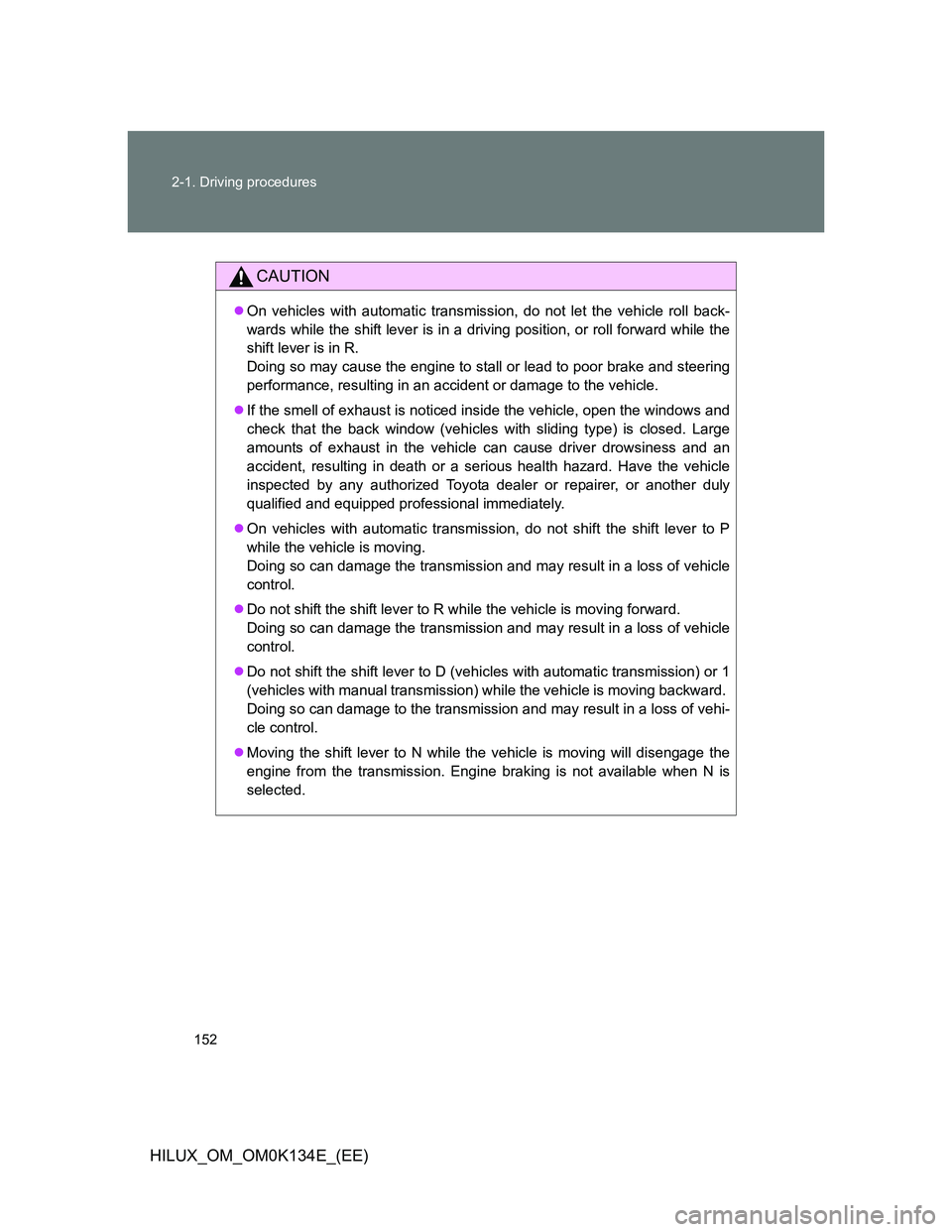2013 TOYOTA HILUX check engine
[x] Cancel search: check enginePage 5 of 644

1
2
3
4
5
6
5
HILUX_OM_OM0K134E_(EE)
3-4. Using the interior lights
Interior lights list .................. 438
• Personal lights .................. 439
• Interior light ....................... 439
3-5. Using the storage features
List of storage features ....... 440
• Glove box ......................... 442
• Console box...................... 443
• Cup holders ...................... 444
• Bottle holders.................... 446
• Auxiliary boxes ................. 447
3-6. Other interior features
Sun visors ........................... 449
Vanity mirror ....................... 450
Clock ................................... 451
Ashtray................................ 452
Cigarette lighter .................. 453
Power outlet ........................ 454
Seat heaters ....................... 455
Floor mat............................. 457
Compass............................. 459
Deck hooks ......................... 4654-1. Maintenance and care
Cleaning and protecting
the vehicle exterior ........... 468
Cleaning and protecting
the vehicle interior ............ 472
4-2. Maintenance
Maintenance
requirements .................... 476
4-3. Do-it-yourself maintenance
Do-it-yourself service
precautions ...................... 480
Hood................................... 484
Engine compartment .......... 486
Tires ................................... 503
Tire inflation pressure......... 507
Wheels ............................... 509
Air conditioning filter ........... 511
Wireless remote control
battery .............................. 513
Checking and replacing
fuses ................................ 516
Light bulbs .......................... 532
4Maintenance and care
Page 41 of 644

41
HILUX_OM_OM0K134E_(EE)
Checking your vehicle’s model
Check the model code to see what type of model your vehicle is.
Driving system
2: 4WD models
3: Pre Runner
Basic code
6: Models with 1KD-FTV engine
5: Models with 2KD-FTV engine
Cab type and Producing country
T: Single-cab made in South Africa
B: Single-cab made in Thailand
C: Extra-cab made in Thailand
P: Double-cab made in South Africa
D: Double-cab made in Thailand
Transmission type
A: Automatic transmission
M: Manual transmission
Grade
D: DLX
S: SR
Destination
W: Models for European countries
H: Models only for Finland
The model code appears on the manufacturer’s label with the head-
ing “MODEL”.
K U N 2 6 – P A D W
Page 152 of 644

152 2-1. Driving procedures
HILUX_OM_OM0K134E_(EE)
CAUTION
On vehicles with automatic transmission, do not let the vehicle roll back-
wards while the shift lever is in a driving position, or roll forward while the
shift lever is in R.
Doing so may cause the engine to stall or lead to poor brake and steering
performance, resulting in an accident or damage to the vehicle.
If the smell of exhaust is noticed inside the vehicle, open the windows and
check that the back window (vehicles with sliding type) is closed. Large
amounts of exhaust in the vehicle can cause driver drowsiness and an
accident, resulting in death or a serious health hazard. Have the vehicle
inspected by any authorized Toyota dealer or repairer, or another duly
qualified and equipped professional immediately.
On vehicles with automatic transmission, do not shift the shift lever to P
while the vehicle is moving.
Doing so can damage the transmission and may result in a loss of vehicle
control.
Do not shift the shift lever to R while the vehicle is moving forward.
Doing so can damage the transmission and may result in a loss of vehicle
control.
Do not shift the shift lever to D (vehicles with automatic transmission) or 1
(vehicles with manual transmission) while the vehicle is moving backward.
Doing so can damage to the transmission and may result in a loss of vehi-
cle control.
Moving the shift lever to N while the vehicle is moving will disengage the
engine from the transmission. Engine braking is not available when N is
selected.
Page 153 of 644

153 2-1. Driving procedures
2
When driving
HILUX_OM_OM0K134E_(EE)
CAUTION
During normal driving, do not turn off the engine. Turning the engine off
while driving will not cause loss of steering or braking control, but the
power assist to these systems will be lost. This will make it more difficult to
steer and brake, so you should pull over and stop the vehicle as soon as it
is safe to do so.
However, in the event of an emergency, such as if it becomes impossible
to stop the vehicle in the normal way: P. 598
Use engine braking (downshift) to maintain a safe speed when driving
down a steep hill.
Using the brakes continuously may cause the brakes to overheat and lose
effectiveness. (P. 167)
Do not adjust the positions of the steering wheel, the seat, or the inside or
outside rear view mirrors while driving.
Doing so may result in a loss of vehicle control that can cause accidents,
resulting in death or serious injury.
Always check that all passengers’ arms, heads or other parts of their body
are not outside the vehicle, as this may result in death or serious injury.
On vehicles with manual transmission, do not operate the clutch halfway
for a long period of time unless it is necessary. Doing so could not only
speed up clutch wear, but could also damage the clutch or even cause a
fatal accident such as vehicle fire.
Page 154 of 644

154 2-1. Driving procedures
HILUX_OM_OM0K134E_(EE)
CAUTION
When driving on slippery road surfaces
Sudden braking, acceleration and steering may cause tire slippage and
reduce your ability to control the vehicle, resulting in an accident.
Sudden changes in engine speed, such as engine braking caused by up-
shifting and down-shifting, may cause the vehicle to skid, resulting in an
accident.
After driving through a puddle, lightly depress the brake pedal to make
sure that the brakes are functioning properly. Wet brake pads may prevent
the brakes from functioning properly. If the brakes on only one side are wet
and not functioning properly, steering control may be affected, resulting in
an accident.
When shifting the shift lever
On vehicles with automatic transmission, be careful not to shift the shift lever
with the accelerator pedal depressed. Shifting the shift lever to a gear other
than P or N may lead to unexpected rapid acceleration of the vehicle that
may cause an accident and result in death or serious injury.
If you hear a squealing or scraping noise (brake pad wear indicators)
Have the brake pads checked and replaced by any authorized Toyota dealer
or repairer, or another duly qualified and equipped professional as soon as
possible.
Rotor damage may result if the pads are not replaced when needed.
It is dangerous to drive the vehicle when the wear limits of the brake pads
and/or those of the brake discs are exceeded.
Page 155 of 644

155 2-1. Driving procedures
2
When driving
HILUX_OM_OM0K134E_(EE)
CAUTION
When the vehicle is stopped
Do not race the engine.
If the vehicle is in any gear other than P (vehicles with automatic transmis-
sion only) or N, the vehicle may accelerate suddenly and unexpectedly,
causing an accident.
Do not leave the vehicle with the engine running for a long time.
If such a situation cannot be avoided, park the vehicle in an open space
and check that exhaust fumes do not enter the vehicle interior.
On vehicles with automatic transmission, in order to prevent accidents due
to the vehicle rolling away, always keep depressing the brake pedal while
the engine is running, and apply the parking brake as necessary.
If the vehicle is stopped on an incline, in order to prevent accidents caused
by the vehicle rolling forward or backward, always depress the brake pedal
and securely apply the parking brake as needed.
Avoid revving or racing the engine.
Running the engine at high speed while the vehicle is stopped may cause
the exhaust system to overheat, which could result in a fire if combustible
material is nearby.
Page 157 of 644

157 2-1. Driving procedures
2
When driving
HILUX_OM_OM0K134E_(EE)
CAUTION
Do not touch the exhaust pipes while the engine is running or immediately
after turning the engine off.
Doing so may cause burns.
Do not leave the engine running in an area with snow build-up, or where it
is snowing. If snowbanks build up around the vehicle while the engine is
running, exhaust gases may collect and enter the vehicle. This may lead
to death or a serious health hazard.
Exhaust gases
Exhaust gases include harmful carbon monoxide (CO), which is colorless
and odorless. Inhaling exhaust gases may lead to death or a serious health
hazard.
If the vehicle is in a poorly ventilated area, stop the engine. In a closed
area, such as a garage, exhaust gases may collect and enter the vehicle.
This may lead to death or a serious health hazard.
The exhaust system should be checked occasionally. If there is a hole or
crack caused by corrosion, damage to a joint or abnormal exhaust noise,
be sure to have the vehicle inspected and repaired by any authorized
Toyota dealer or repairer, or another duly qualified and equipped profes-
sional. Failure to do so may allow exhaust gases to enter the vehicle,
resulting in death or a serious health hazard.
Toyota does not recommend occupying the rear cargo area when it is fitted
with a slide-in camper, camper shell or other type cover while the engine is
running. This caution applies to both driving and stopped or parked situa-
tions with the engine running. Particular care should be taken to prevent
exhaust gases from entering camper bodies, trailers or other enclosures
on or around your vehicle. If exhaust fumes are detected, open all win-
dows and thoroughly ventilate the area.
Page 161 of 644

161 2-1. Driving procedures
2
When driving
HILUX_OM_OM0K134E_(EE)
NOTICE
When encountering flooded roads
Do not drive on a road that has flooded after heavy rain etc. Doing so may
cause the following serious damage to the vehicle:
Engine stalling
Short in electrical components
Engine damage caused by water immersion
In the event that you drive on a flooded road and the vehicle is flooded, be
sure to have any authorized Toyota dealer or repairer, or another duly quali-
fied and equipped professional check the following:
Brake function
Changes in quantity and quality of oil and fluid used for the engine, trans-
mission, transfer (4WD models), differential, etc.
Lubricant condition for the propeller shaft, bearings and suspension joints
(where possible), and the function of all joints, bearings, etc.